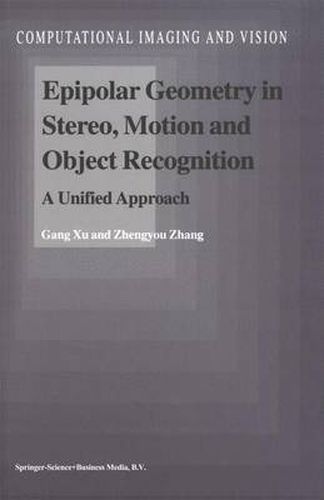Readings Newsletter
Become a Readings Member to make your shopping experience even easier.
Sign in or sign up for free!
You’re not far away from qualifying for FREE standard shipping within Australia
You’ve qualified for FREE standard shipping within Australia
The cart is loading…






This title is printed to order. This book may have been self-published. If so, we cannot guarantee the quality of the content. In the main most books will have gone through the editing process however some may not. We therefore suggest that you be aware of this before ordering this book. If in doubt check either the author or publisher’s details as we are unable to accept any returns unless they are faulty. Please contact us if you have any questions.
This text deals with one of the oldest problems in computer vision, namely to recover the 3-D geometric and kinematic structures of the world from two images, and to recognise a 3-D object in a cluttered scene from one or several views of this object in a different setting. Several different problems have been unified through the use of a unique geometric concept. On the one hand, the geometrical point of view naturally leads to the consideration of the projective geometric structure which relates two images of the same object, the epipolar structure. On the other hand, the practitioner’s point of view allows the reduction of the difficult 2-D search tasks encountered in the fundamental problems to much simpler 1-D search tasks, and, for the theoretically inclined reader, it ties the projective, affine and Euclidean structures of the scene to those of the images. Audience: The authors have managed to avoid projective geometry in their exposition, and to guide the reader through the various aspects of epipolar geometry, stereo vision, motion analysis and object recognition using only the standard tools of linear algebra, thus making this a valuable book for a wide audience of researchers and engineers in image-related fields like vision, image processing, computer graphics, robotics, multi-media, and virtual reality.
$9.00 standard shipping within Australia
FREE standard shipping within Australia for orders over $100.00
Express & International shipping calculated at checkout
This title is printed to order. This book may have been self-published. If so, we cannot guarantee the quality of the content. In the main most books will have gone through the editing process however some may not. We therefore suggest that you be aware of this before ordering this book. If in doubt check either the author or publisher’s details as we are unable to accept any returns unless they are faulty. Please contact us if you have any questions.
This text deals with one of the oldest problems in computer vision, namely to recover the 3-D geometric and kinematic structures of the world from two images, and to recognise a 3-D object in a cluttered scene from one or several views of this object in a different setting. Several different problems have been unified through the use of a unique geometric concept. On the one hand, the geometrical point of view naturally leads to the consideration of the projective geometric structure which relates two images of the same object, the epipolar structure. On the other hand, the practitioner’s point of view allows the reduction of the difficult 2-D search tasks encountered in the fundamental problems to much simpler 1-D search tasks, and, for the theoretically inclined reader, it ties the projective, affine and Euclidean structures of the scene to those of the images. Audience: The authors have managed to avoid projective geometry in their exposition, and to guide the reader through the various aspects of epipolar geometry, stereo vision, motion analysis and object recognition using only the standard tools of linear algebra, thus making this a valuable book for a wide audience of researchers and engineers in image-related fields like vision, image processing, computer graphics, robotics, multi-media, and virtual reality.